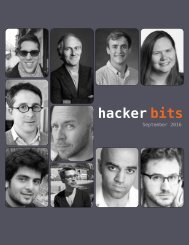Hacker Bits, April 2016
HACKER BITS is the monthly magazine that gives you the hottest technology and startup stories crowdsources by the readers of Hacker News. We select from the top voted stories for you and publish them in an easy-to-read magazine format. Get HACKER BITS delivered to your inbox every month! For more, visit http://hackerbits.com.
HACKER BITS is the monthly magazine that gives you the hottest technology and startup stories crowdsources by the readers of Hacker News. We select from the top voted stories for you and publish them in an easy-to-read magazine format.
Get HACKER BITS delivered to your inbox every month! For more, visit http://hackerbits.com.
You also want an ePaper? Increase the reach of your titles
YUMPU automatically turns print PDFs into web optimized ePapers that Google loves.
ecause the first app was born<br />
at midnight, January 1, 1970.<br />
The app was a custom emoji<br />
pack for an ancient model of<br />
phone that would one day evolve<br />
to become the first Blackberry.<br />
If you’re wondering why the<br />
response starts with “for (;;);”,<br />
it’s to, among other things,<br />
encourage developers to use a<br />
quality JSON decoder, instead of<br />
like, y’know, eval().<br />
Anyway that “la” thing stands<br />
for “last active”, and tells you<br />
the last time the person was<br />
active on Facebook, down to the<br />
second. Do you see where I’m<br />
going with this?<br />
Figure 3: Console snooping<br />
• “webStatus”: “idle” means<br />
their web browser is logged<br />
in to Facebook, and has the<br />
page open, but they aren’t<br />
doing anything on the site<br />
like moving their mouse or<br />
talking to anyone.<br />
• Since we have both of these<br />
at the same time, we can tell<br />
that this person is likely not<br />
using their phone, and that<br />
they were using facebook.<br />
com recently, but not right<br />
now.<br />
That’s already a little creepy<br />
that we can tell that about people.<br />
But can we do more with<br />
this?<br />
You might also notice that<br />
there is a value called “la” that<br />
is a big integer that starts with<br />
"14." If you I dunno, didn’t have<br />
a lot of friends in high school,<br />
you might recognise that as a<br />
UNIX time stamp — the time in<br />
seconds since midnight, January<br />
1, 1970.<br />
Computer scientists thought<br />
this would be a good time to<br />
start measuring the time from<br />
Roleplaying as the<br />
NSA<br />
So far we have a whole bunch of<br />
things which look like this:<br />
• A person<br />
• A time<br />
• Whether they’re online or<br />
offline or idle<br />
• Which devices they’re online/offline/idle<br />
on<br />
This doesn’t seem that interesting<br />
at first, since you already<br />
know who is online by looking<br />
at the sidebar. But what if there<br />
was someone always watching<br />
the little green dots?<br />
Using the power of computers,<br />
you can just write a Python<br />
program to listen to what the<br />
/pull requests are saying all the<br />
time ever, and write it down.<br />
Here’s a screenshot of all the<br />
log files I’ve got. (see Figure 4)<br />
And here’s what an individual<br />
log file looks like (the first 10<br />
lines). (see Figure 5)<br />
Those blurred out things are<br />
Facebook user ids. If you think<br />
these screenshots look a little<br />
bit creepy then YEAH I KNOW<br />
RIGHT.<br />
42 hacker bits















